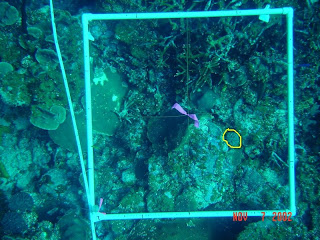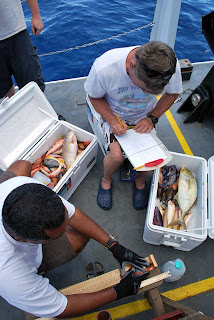 As we have had a day to contemplate the outcomes of the cruise, I think everyone is fairly pleased. Completed reef assessment objectives included reef fish visual census at 69 stratified random sites with photo-quadrats at 36 of these sites to characterize benthic cover. Among these random sites, only 7 were observed to host ESA listed staghorn coral (small, isolated colonies) while the invasive Pacific red lionfish were observed at four. Of the almost 29000 individual fish recorded in visual censuses, only 15 individuals were of large grouper species (Nassau, yellowmouth, and hind). Permanently tagged ESA listed elkhorn coral colonies were re-surveyed and all colonies along the southwest coast were mapped. This population remains in excellent condition. For the first time, the project (in collaboration with FoProBIM) was able to obtain pilot catch data (two boat-days worth were identified and measured) from the Haitian fishers who frequent Navassa waters. Reef temperature data was also retrieved from two logging sensors deployed in 2006. We look forward to compiling our results more completely and providing them to natural resource managers at the Caribbean Islands National Wildlife Refuge and the Caribbean Fishery Management Council. We never know when or if our next opportunity might be to visit Navassa, so while we are all happy to be headed home, we are all mindful of what ongoing changes may occur under the crystal clear waters of Navassa.
As we have had a day to contemplate the outcomes of the cruise, I think everyone is fairly pleased. Completed reef assessment objectives included reef fish visual census at 69 stratified random sites with photo-quadrats at 36 of these sites to characterize benthic cover. Among these random sites, only 7 were observed to host ESA listed staghorn coral (small, isolated colonies) while the invasive Pacific red lionfish were observed at four. Of the almost 29000 individual fish recorded in visual censuses, only 15 individuals were of large grouper species (Nassau, yellowmouth, and hind). Permanently tagged ESA listed elkhorn coral colonies were re-surveyed and all colonies along the southwest coast were mapped. This population remains in excellent condition. For the first time, the project (in collaboration with FoProBIM) was able to obtain pilot catch data (two boat-days worth were identified and measured) from the Haitian fishers who frequent Navassa waters. Reef temperature data was also retrieved from two logging sensors deployed in 2006. We look forward to compiling our results more completely and providing them to natural resource managers at the Caribbean Islands National Wildlife Refuge and the Caribbean Fishery Management Council. We never know when or if our next opportunity might be to visit Navassa, so while we are all happy to be headed home, we are all mindful of what ongoing changes may occur under the crystal clear waters of Navassa.--Margaret Miller



















































+acopy.jpg)
